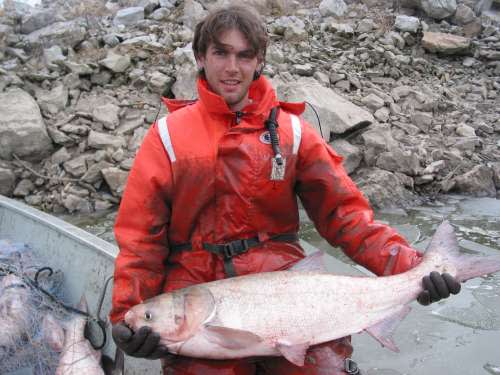First Evidence of Asian Carp Breeding in Lake Erie Basin Unearthed
OutdoorHub Reporters 10.29.13

Scientists with the US Geological Survey (USGS) announced on Monday the first confirmation of Asian carp breeding in the Lake Erie Basin. The study verified that four grass carp taken last year in Ohio’s Sandusky River are in fact the result of natural reproduction.
“People have been catching grass carp intermittently in the Great Lakes for a long time, but a lot of people assumed that those carp were sterile,” said USGS scientist Duane Chapman, who was lead author on the study.
Chapman told OutdoorHub that it was only recently that researchers were able to come up with methods to test grass carp for a history of the waterways it visited. One of these methods involved studying bones in the fish called “otoliths.” Because the Sandusky River had a naturally high strontium to calcium ratio, the fish living in the area will also contain higher strontium levels in their otoliths. Chapman and his team used a sophisticated laser to vaporize small deposits of bone from the surface of the otoliths and tested for strontium. Using data from pond-raised fish as a reference, researchers found that the strontium levels in the Sandusky River grass carp indicated that the fish lived there for their entire lives.
“The Sandusky River is unique in its chemistry and geology,” Chapman said.
Unfortunately, the river also flows right into Lake Erie. Only the Ballville Dam, a 407-foot long 35-foot high structure, can prevent grass carp from entering the Sandusky Bay and Lake Erie proper. Dams are important because they can create “settling zones” where carp eggs collect and sink, usually resulting in their demise. In addition to preventing the travel of carp eggs, dams also decrease the length that the eggs have to drift. However, the four specimens used by Chapman’s team were found downstream from the dam.
When asked whether carp could easily access Lake Erie, Chapman replied, “any Asian carp downstream from Ballville Dam can.”
Ballville Dam was originally slated to be removed in 2012, due to concerns that it may be polluting the waters of nearby Fremont with nitrates.
“They only have 25 kilometers of river to deal with,” Chapman added. “They can swim right out.”
Chapman said he found no traces of bighead or silver carp in the Sandusky River, two of the more destructive Asian carp species. In comparison, grass carp are a much less threatening nuisance and are still used for agricultural purposes across the nation. Bighead and silver carp can and will out-compete native fish for food, and are notoriously hard to catch. All three species fall under the umbrella term “Asian carp” to denote their invasive status.
Grass carp are not completely benign, however. Due to the fish’s voracious plant-eating habits, some worry that grass carp can damage vegetation vital to other species.
Asian carp have earned a reputation as one of the nation’s most dangerous invasive species after they escaped into the Mississippi River in the early 1970s. Their quick reproduction rate and adaptability made colonization across the Mississippi an easy task, and have been laying siege to the Great Lakes for years.
Chapman says that because carp share similar habitat requirements, the study is an indication that bighead and silver carp could also reproduce in the Sandusky River.
“It certainly provides validation for a recent study that Asian carp could live in shorter rivers like the Sandusky,” he said.
The study Chapman mentioned is a report by the USGS that stated Asian carp can spawn in more Great Lake tributaries than previously thought. The report caused researchers to expand the number of tributaries that could host spawning carp, including rivers as short as 16 miles.
The USGS conducted the study in cooperation with Bowling Green State University and the Ohio Department of Natural Resources.
Edit added 10/30/2013: article has been updated to reflect that the grass carp specimens used by the USGS scientists were found downstream of the Ballville Dam.

